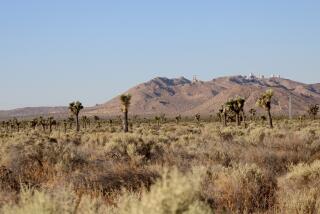Arco Solar : Chatsworth Firm Tempers Forecasts for Solar Energy
- Share via
Arco Solar Inc. introduced its latest solar electricity-generating device in December to raves from industry analysts. Brisk sales of its Genesis module, which is powerful enough to run a small television set, already have solidified the Chatsworth company’s position as the industry sales leader.
Yet there is a new, cautious tone at Arco Solar, a wholly owned subsidiary of Atlantic Richfield Co., as well as in the entire photovoltaic industry.
For a decade, solar power enthusiasts at Arco and elsewhere have predicted that in the 1990s huge fields of electricity-generating solar panels will replace oil, coal and nuclear power plants.
Scaled-Down Focus
Although expressing hope that such large-scale applications will still occur, Arco is now concentrating on a much smaller market, selling panels to owners of recreational vehicles, boats, remote cabins and to developing countries, mainly to pump water in villages.
“If we strike it big with orders for utility plants, that’s wonderful,” Arco Solar President James H. Caldwell Jr. said in an interview. “But, if not, we’ve got a good, solid business here anyway, selling to the consumer market.”
Unlike the more familiar heat-generating solar panels, which use sunlight to heat water or air, photovoltaic solar cells convert solar energy directly into electricity.
Enthusiasts point out that sunlight is free of cost, free of pollution, free from the threat of boycotts, inexhaustible.
Large Potential
A frequently cited study by Aerospace Corp. of El Segundo reported that, if the photovoltaic cell becomes cost-competitive, it could provide California with as much as 25% of its electricity.
In contrast to the estimated $385-million worldwide market in 1985 for photovoltaic cells, the utility market would be in the tens of billions of dollars, analysts say.
The cost of the cells themselves continues to be the problem.
Until a few years ago, it took more energy to make a photovoltaic cell than one would generate during its estimated 20-year life.
Despite dramatic cost reductions in recent years, the cheapest photovoltaic power still costs nearly 10 times as much as power from conventional sources.
Also, industry analysts say, solar power has yet to stir much interest among private investors, whose participation is essential, or from utilities, which remain oriented toward oil, coal and nuclear power.
Significantly, Arco scrapped plans last year to expand a large photovoltaic plant near San Luis Obispo when investors could not be found.
Also, federal tax credits aimed at giving the infant solar industry a boost are to expire at the end of this year, and most observers doubt that Congress will extend them.
In 1983 Caldwell predicted that within six years the cost of coal-generated power would nearly triple, to 15 cents a kilowatt hour, while photovoltaic power would drop to 15 cents a kilowatt hour.
In a recent interview, he declined to renew that prediction, saying the “short-term future for sales to utilities remains unclear, which is why our plans at present are not geared to utility-scale applications.”
Cause of Reservations
Fallout from the industry’s failure to fulfill past promises is the cause of the “conservative to slightly pessimistic public attitude in the photovoltaic industry at the moment,” said Robert O. Johnson, photovoltaics research manager for Strategies Unlimited, a Mountain View, Calif., market research firm.
Arco and other photovoltaic firms are “biding their time,” waiting for oil and coal prices to resume their upward spiral and for the costs for conventional power plants to go up, Johnson said, “and in the interim there is a fast-growing consumer market to look to.”
But Robert Carbone, a Berkeley photovoltaic investment adviser, scoffed at the notion that Arco is concentrating on consumer applications.
“That’s what some industry leaders are saying about their firms these days,” he said. “In Arco’s case, I don’t believe it. They’re going for the long bomb because it’s what they do best.
Industry Leaders Blamed
Even though worldwide photovoltaic sales have climbed from $27 million in 1980 to an estimated $385 million this year, Carbone said, Arco is “never going to make real money selling panels to marijuana growers in Northern California, and they know it.”
In Carbone’s view, industry output would explode if a single utility would commit now to a large photovoltaic power plant.
But he said there are “too many vested interests” working against a change to solar power.
Carbone said these include the utilities, which could lose their monopoly on power generation and distribution, and the steel and cement industries and organized labor, all of which are involved in power plant construction.
Nonetheless, he predicted that rising demand for power, plus public animosity to pollution from conventional plants, “will force utilities to begin seriously looking at photovoltaics, probably in three to five years.”
More than any other solar firm, Arco is responsible for demonstrating that photovoltaic cells can generate power in large quantities.
Three Plants Built
In 1982 Arco built the world’s first photovoltaic central utility power plant, a 1-megawatt facilty near Hesperia that generates enough power for 300 to 400 typical homes.
In November, 1983, Arco completed construction of a 6-megawatt plant near San Luis Obispo, and in 1984 it finished a 1.2-megawatt plant near Sacramento.
Although conceding that the plants’ cost per unit of electricity is not competitive with conventional plants, Arco officials say all three facilities are operating trouble-free, providing proof of the long-term reliability of solar cells.
Atlantic Richfield, the nation’s seventh-largest oil company with 1984 revenues of $25 billion, entered the solar field in September, 1977, when it purchased Solar Technology International, a nine-employee shop started two years earlier in Chatsworth.
Solar Cell Factory
Renamed Arco Solar, the firm built what company officials say is the world’s first automated solar cell factory in Camarillo. It employs 280 persons and in 1984 sold an estimated $48 million in solar cells.
Before the introduction of thin-film amorphous silicon cells such as the Genesis module, all silicon for photovoltaic panels was created in much the same way as silicon is produced for semiconductor chips.
It is heated, formed into a sausage-like single crystal and then sawed into wafers. The slices are placed in rows on a sheet of glass and connected by hand by wires.
Sunlight striking the surface of the wafers creates a stream of electrons that are captured as electricity.
Unconventional Process
Unlike conventional cells, the Genesis module is created by spraying amorphous silicon in a gaseous state onto a sheet of glass to which a wire grid has already been applied.
This process reduces the number of solder joints needed for a one-square-foot panel from 500 to 2, an Arco spokesman said, and uses only one-thousandth as much silicon per square foot of solar panel.
Although other firms, especially Japanese companies, have used amorphous silicon for several years in watches and calculators, Arco in December became the first to market large modules incorporating the new technology.
Arco officials say the one-square-foot Genesis module, which retails for about $100, produces 5 watts under midday sunshine.
A second Camarillo plant, which will double production capacity, is in the planning stages and could be open by 1987, company officials said.
More to Read
Inside the business of entertainment
The Wide Shot brings you news, analysis and insights on everything from streaming wars to production — and what it all means for the future.
You may occasionally receive promotional content from the Los Angeles Times.










